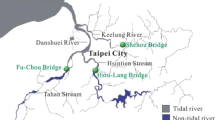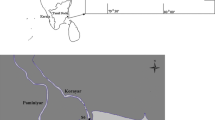Abstract
The reaeration coefficient (K a) is an essential parameter to predict the dissolved-oxygen concentration in different aquatic ecosystems. The techniques applied to K a estimates require considerable efforts, since measuring this coefficient is a laborious and expensive task. Thus, the use of predictive equations wherein K a is found through hydraulic flow parameters is common. However, the available prediction equations lead to estimates often different from each other. A new predictive equation is addressed in the present study. The insertion of a dimensionless number resulting from the relation between the RMS (Root Mean Square) of the free-surface vertical velocity and the surface flow velocity is the great innovation of the study. The reaeration experiments and the surface vertical velocity mapping were performed in a circular hydraulic channel. The flow velocity varied from 0.25 to 0.64 m s−1, and depth varied from 0.09 to 0.15 m. The new equation led to more accurate results than the equations based on traditional hydraulic parameters such as the Reynolds and Froude numbers, mainly when it comes to K a values higher than 40 day−1. The sensitivity analysis has shown that the new dimensionless number is the most sensitive parameter of the herein proposed predictive equation and that the influence from the Reynolds and Froude numbers on K a weakens as turbulence gets more intense.





Similar content being viewed by others
References
ASCE. (2007). Measurement of oxygen in clear water, ASCE/SEI 2-06, Reston, Virginia.
Bennett, J. P., & Rathbun, R. E. (1972). Reaeration in open channel flow (p. 86). Washington: United States Department of the Interior.
Bicudo, J., & James, A. (1989). Measurement of reaeration in streams: comparison of techniques. Journal of Environmental Engineering. doi:10.1061/(ASCE)0733-9372(1989)115:5(992.
Chapra, S. C., & Di Toro, D. M. (1991). Delta method for estimating primary production, respiration and reaeration in streams. Journal of Environmental Engineering. doi:10.1061/(ASCE)0733-9372(1991)117:5(640.
Chiapponi, L., Longo, M., & Tonelli, M. (2012). Experimental study on oscillating grid turbulence and free surface fluctuation. Experiments in Fluids. doi:10.1007/s00348-012-1367-4.
Churchill, M. A., Elmore, H. L., & Buckingham, R. A. (1962). The prediction of stream reaeration rates. Journal Sanitary Engineering Division, 4(88), 1–46.
Copeland B. J., & Duffer W. R. (1964). Use of a clear plastic dome to measure gaseous diffusion rates in natural waters. Limnology and Oceanography, 9(4), 494–499.
Elmore, H. L., & West, W. F. (1961). Effect of water temperature on stream reaeration. Journal of the Sanitary Engineering Division ASCE, 87(6), 59–71.
Gonçalves, J. C. S. I., & Giorgetti, M. F. (2013). Mathematical model for the simulation of water quality in river using the Vensim PLE software. Journal of Urban and Environmental Enginnering. doi:10.4090/juee.2013.v7n1.
Gonçalves, J. C. S. I., Costa, D. J. L., Silveira, A., & Giorgetti, M. F. (2013). Reoxigenação superficial e sumidouro físico de oxigênio dissolvido em um tanque agitado por jatos. Revista Brasileira de Recursos Hídricos, 18(3), 231–240.
Gualtieri, C., Gualtieri, P., & Doria, G. P. (2002). Dimensional analysis of reaeration rate in stream. Journal of Environmental Engineering. doi:10.1061/(ASCE)0733-9372(2002)128:1(12)#sthash.3qXpq92l.dpuf.
Haider, H., Ali, W., & Haydar, S. (2012). Evaluation of various relationships of reaeration rate coefficient of modeling dissolved oxygen in a river with extreme flow variations in Pakistan. Hydrological Processes. doi:10.1002/hyp.9528.
Jha, R., Ojha, C. S. P., & Bhatia, K. K. S. (2001). Refinement of predictive reaeration equations for a typical Indian river. Hydrological Processes. doi:10.1002/hyp.177.
Jha, R., Ojha, C. S. P., & Bhatia, K. K. S. (2004). A supplementary approach for estimating reaeration rate coefficients. Hydrological Processes. doi:10.1002/hyp.1312.
Jin, H. S., White, D. S., Ramsey, J. B., & Kipphut, G. W. (2012). Mixed tracer injection method to measure reaeration coefficients in small streams. Water, Air, and Soil Pollution, 223, 5297. doi:10.1007/s11270 012-1280-8.
Kalburgi, P. B., Jha, R., Ojha, C. S. P., & Deshannavar, U. B. (2015). Evaluation of re-aeration equations for river Ghataprabha, Karnataka, India and development of refined equation. Environmental Technology. doi:10.1080/09593330.2014.937770.
Langbein, W. B., & Durum, W. H. (1967). The aeration capacity of stream. Washington: U.S. Geological Survey.
Liu, B., Wang, W., Han, R., Ming Sheng, L. Y., Du, X., Wu, X., & Wang, G. (2016). Dynamics of dissolved oxygen and the affecting factors in sediment of polluted urban rivers under aeration treatment. Water, Air, and Soil Pollution, 227, 172. doi:10.1007/s11270-016-2869-0.
Longo, S. (2010). Experiments on turbulence beneath a free surface in a stationary field generated by a Crump weir: free surface characteristics and the relevant scales. Experiments in Fluids, 49, 1325–1338.
Longo, S. (2011). Experiments on turbulence beneath a free surface in a stationary field generated by a Crump weir: turbulence structure and correlation with the free surface. Experiments in Fluids, 50, 201–215.
Longo, S., Chiapponi, L., Clavero, M., Makela, T., & Liang, D. (2012a). Study of the turbulence in the air-side and water-side boundary layers in experimental laboratory wind induced surface waves. Coastal Engineering, 69, 67–81.
Longo, S., Liang, D., Chiapponi, L., & Aguilera, J. L. (2012b). Turbulent flow structure in experimental laboratory wind-generated gravity waves. Coastal Engineering, 64, 1–15.
Maradei, G., Veltri, P., Morosini, A. F., & Verbeni, B. (2015). Laboratory study on the open channel flow reaeration: a dimensional approach. Urban Water Journal, 12(4), 295–304.
Melching, C. S., & Flores, H. E. (1999). Reaeration equations derived from U. S. Geological Survey Database. Journal of Environmental Engineering. doi:10.1061/(ASCE)0733-9372(1999)125:5(407.
Menezes, J. P. C., Bittencourt, R. P., Farias, M. S., Bello, I. P., De Oliveira, L. F. C., & Fia, R. (2015). Deoxygenation rate, reaeration and potential for self-purification of a small tropical urban stream. Revista Ambiente & Água. doi:10.4136/ambi-agua.1599.
Moog, D. B., & Jirka, G. H. (1998). Analysis of reaeration equations using mean multiplicative error. Journal of Environmental Engineering. doi:10.1061/(ASCE)0733-9372(1998)124:2(104)#sthash.CVytCozQ.dpuf.
Morse, N., Bowden, W. B., Hackman, A., Pruden, C., Steiner, E., & Berger, E. (2007). Using sound pressure to estimate reaeration in streams. Journal of the North American Benthological Society, 26, 28–37.
Nguyen, M. T., Appan, A., Tan, D. S., & Tan, S. K. (2013). Influence of small water surface perturbations on the reaeration process. Journal of Environmental Engineering. doi:10.1061/(ASCE)EE.1943-7870.000079.
O'Connor, D. J., & Dobbins, W. E. (1958). Mechanism of reaeration in natural streams. Transactions of the American Society of Civil Engineers, 23, 641–666.
Omole, D. O., Longe, E. O., & Musa, A. G. (2013). An approach to reaeration coefficient modeling in local surface water quality monitoring. Environmental Modeling and Assessment, 18, 85–94.
Owens, M., Edwards, R. W., & Gibbs, J. W. (1964). Some reaeration studies in stream. International Journal of Air and Water Pollution, 8/9(8), 469–486.
Palumbo, J. E., & Brown, L. C. (2013). Assessing the performance of reaeration prediction equations. Journal of Environmental Engineering. doi:10.1061/(ASCE)EE.1943-7870.0000799.
Popel, H. J. (1979). Aeration and gas transfer (2nd ed.). Delft: Delft University of Technology.
Queiroz, F. M., Matos, A. T., & Von Sperling, M. (2015). Estimativa do coeficiente de reaeração da água em canal raso de fundo deslizante. Eng Sanit Ambient. doi:10.1590/S1413-41522015020000113819.
Rathbun, R. E., Shultz, D. J., & Stephens, D. W. (1975). Preliminary experiments with a modified tracer technique for measuring stream reaeration coefficients, U. S. geological survey open-file report 75–256. Washington, DC: U. S Geological Survey.
Streeter, H. W., & Phelps, E. B. (1925). A study of the pollution and natural purification of the Ohio river (p. 146). Washington, D. C: U. S. Public Health Service.
Szeliga, M. R., & Roma, W. N. L. (2004). Sistema de visão computacional para medição de turbulência e correlação com a reaeração de corpos d’água receptores. Engenharia Sanitária e Ambiental, 9(1), 30–44.
Szeliga, M. R., & Roma, W. N. L. (2009). Estudos de Reaeração com Velocimetria por Imagens de Partículas- Sistema S-PIV-3D. Engenharia Sanitária e Ambiental. doi:10.1590/S1413-41522009000400010.
Tsivoglou, E. C., O’connel, R. L., Walter, C. M., Godsil, P. J., & Logsdon, G. S. (1965). Tracer measurements of atmospheric reaeration, laboratory studies. Journal of Water Pollution Control Federation, 37(10), 1343–1362.
Zahraeifard, V., & Deng, Z. (2012). VART model-based method for estimation of instream dissolved oxygen and Reaeration coefficient. Journal of Environmental Engineering. doi:10.1061/(ASCE)EE.1943-7870.0000494.
Zhang, R., Qian, X., Li, H., Yuan, X., & Ye, R. (2012). Selection of optimal river water quality improvement programs using QUAL2K: a case study of Taihu Lake Basin, China. Science of the Total Environment, 431, 278–285.
Zhu, H., Huang, G. H., & Guo, P. (2012). SIFNP: simulation-based interval-fuzzy nonlinear programming for seasonal planning of stream water quality management. Water, Air, and Soil Pollution, 223, 2051. doi:10.1007/s11270-011-1004-5.
Author information
Authors and Affiliations
Corresponding author
Rights and permissions
About this article
Cite this article
de Souza Inácio Gonçalves, J.C., Silveira, A., Lopes Júnior, G.B. et al. Reaeration Coefficient Estimate: New Parameter for Predictive Equations. Water Air Soil Pollut 228, 307 (2017). https://doi.org/10.1007/s11270-017-3491-5
Received:
Accepted:
Published:
DOI: https://doi.org/10.1007/s11270-017-3491-5




